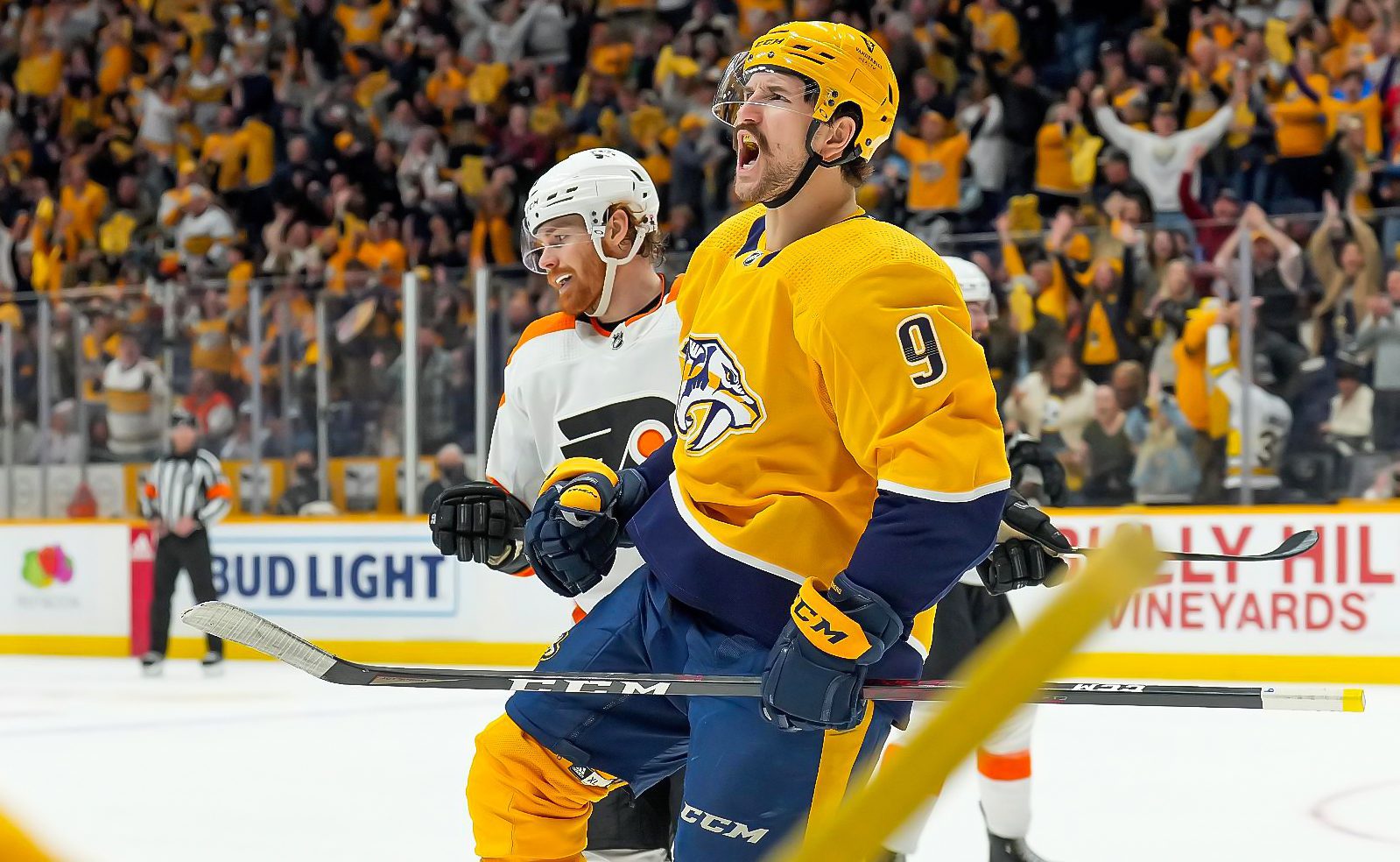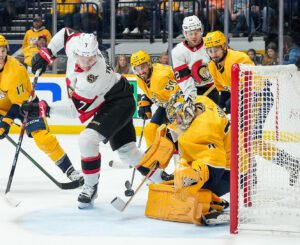Nashville Predators
Debate: Is Filip Forsberg A Top-20 Winger?

NHL Network recently revealed its ranking of the top 20 wingers in the league right now and there was one notable omission: Nashville Predators forward Filip Forsberg.
Here are the Top 20 Wingers in the NHL right now!
What do you think of this list? #NHLTopPlayers pic.twitter.com/2ceyRuyWHv
— NHL Network (@NHLNetwork) August 13, 2023
A three-time 30-goal scorer and four-time 60-point producer, Forsberg holds several Predators records including all-time goals (239), game-winning goals (43) and hat tricks (8), but it’s long been debated whether the 29-year-old Swede is actually among the NHL’s elite.
Our panel of Predators writers weigh in on whether Forsberg was snubbed from the NHL Network rankings and discuss where exactly he falls among the top wingers in the NHL:
Was Forsberg snubbed by NHL Network? If he made the list, how high should he have been ranked?
Michael Gallagher: Absolutely, he was. Since becoming a full-time NHL player in 2014, Forsberg ranks ninth among wings in goals (238) and 17th in points (505), and only four left wingers have more goals and five have more points than he does over that span.
Aside from this season, Ryan Nugent-Hopkins had never had a 30-goal season and he scored more than 25 goals just once in his previous 10 seasons. Jake Guentzel’s numbers are slightly inflated due to playing on Sidney Crosby‘s line, Mark Stone has topped the 25-goal plateau just twice in nine seasons, Forsberg has more goals than Johnny Gaudreau over the last nine seasons, and Patrick Kane is old, injured and not the player he used to be. On this list, I’d probably put Forsberg as high as No. 16.
Nick Kieser: Only snubbed of the thought to be in the NHL Network rankings. While he did score 42 goals two seasons ago, he’s been the Predators most consistent winger since he became an everyday NHLer.
Here’s where Forsberg’s point production ranks among LWs over the last nine seasons:
- 42 points in 50 GP — 40th
- 84 points in 69 GP — 8th
- 32 points in 39 GP — 32nd
- 48 points in 63 GP — 19th
- 50 points in 64 GP — 20th
- 64 points in 67 GP — 10th
- 58 points in 82 GP — 12th
- 64 points in 82 GP — 6th
- 63 points in 82 GP — 9th
At times Forsberg has been a flashy player, but for the most part, it’s his prolific puck skills that have put him in prime spots to be effective. Injuries have hampered his ability to bolster his resume, and a concussion kept him out for the better half of last season, which surely didn’t help his case to crack the top 20 this season.
Clay Brewer: Forsberg is a very good player and has the potential to reach elite status, but he’s just not there yet. Despite missing 40 percent of the season, Forsberg was still nearly a point-per-game player. If he had another 40-goal season last year, or even reached the high 30s, I would say he’s well on his way.
Including him on the list over another forward in the top 20 isn’t simply a black-and-white issue. While his 42 points last year can be chalked up as a one-off because he only played in 50 games, but being elite requires consistency.
Unfortunately, injuries have been an issue with Forsberg, and he hasn’t played in 70 or more games since the 2016-17 season when he played in all 82 (though there are two COVID-shortened seasons to take into account). On-ice production, of course, is part of being elite, but durability must also factor into the equation. That’s not a dig at Forsberg — any of the other 31 teams would be significantly better with him on their roster.
Is playing with Ryan O’Reilly the key to unlocking Forsberg’s scoring potential?
Gallagher: I wouldn’t exactly phrase it that way, but I do think having O’Reilly center Forsberg will open many more scoring chances for him. O’Reilly is a playmaker with excellent vision and a real nose for scoring opportunities, who prior to last season, had a run of nine straight years with 30 or more assists.
Yes, Forsberg had a career year just two seasons ago with Mikael Granlund as his primary center, but except for 2018-19 Ryan Johansen, he’s largely played with a revolving door of inconsistency from his centerman over the years (Granlund, Kyle Turris, Matt Duchene, Mike Riberio). Playing on a line with O’Reilly, in Brunette’s offensively aggressive system, I think 35 goals and 70 points is very doable for Forsberg in 2023.


Ryan O’Reilly, left, holds off Dante Fabbro as they jockey for position in front of the net. Photo by John Russell/Nashville Predators
Kieser: O’Reilly could be Nashville’s best version of a Patrice Bergeron up the middle; he’ll drive the play and back-check like a bat out of hell. Forsberg will need to acclimate to O’Reilly’s style of play if they do end up on a line together.
If the newly acquired veteran can feather Forsberg some passes in his wheelhouse, I’d look out if I played defense for one of the other 31 teams. During the 2021-22 season, O’Reilly’s line with David Perron and Brandon Saad produced 72 goals for the St. Louis Blues. Perhaps if Luke Evangelista or Gustav Nyquist were plugged in on his line with the Predators, similar results will follow.
Brewer: I’ve been adamant since he signed on July 1 that O’Reilly will be a great fit in Nashville, which has been missing the right mixture of size, speed, and skill on its top line for a long time.
I’d like to see Juuso Parssinen join Forsberg and O’Reilly on that top line. Forsberg has the ability to reach his scoring potential with a strong, experienced center like O’Reilly and a young, vibrant forward like Parssinen on the opposite wing. I think his addition would really accelerate Forsberg’s game even more.
If Forsberg has another 40-goal season, where should he rank on this list next year?
Gallagher: I don’t know if two 40-goal seasons in three years is enough to put him ahead of Steven Stamkos, who’s scored 40 or more multiple times, or William Nylander, who has back-to-back 80-point seasons, but it surely gets him into the top 15. It definitely moves him ahead of Nugent-Hopkins, Stone, Kane, and likely Guentzel, but I wouldn’t feel comfortable slotting Forsberg ahead of Nylander or Kyle Connor, who has 30 or more goals in five of his last six seasons.
Kieser: It’s not a pipe dream to think that Forsberg can reach 40 goals under new head coach Andrew Brunette, who’s more of a player’s coach. But that also depends on how consistent the lineup is from game to game and whether Forsberg can stay healthy, of course. It’s possible the Swede could lead the team in scoring after having the second-worst statistical season of his career. Special teams have been his friend; he’s scored double-digit points eight times on the man advantage. If he exploded offensively this season, I’d put him at No. 12 next year.
Brewer: I could definitely see Forsberg putting up Jason Robertson-like numbers if he remains consistent and stays healthy. So yes, another 40-goal season would put him in the conversation. Forsberg had 19 goals in 50 games last year, which translates to 31 goals over an 82-game season.
If he were to record a second 40-goal season, that would undeniably put him in the elite conversation, which would certainly guarantee him a spot on this list next year, and he could maybe even break into the top 10. I have no doubt if he had stayed healthy and hit at least 30 goals, he would’ve likely made the cut this year. Many of the players on the list have had an off season or two, but consistency always helps settle debates such as this. Robertson got a nice boost from his back-to-back 40-goal seasons, and he’s only 24.
Which player ranked 11-20 would be an upgrade over Forsberg on the Predators roster right now?
Gallagher: I know the sexy answer is either Nylander or Brady Tkachuk, but I’m inclined to go with Connor. He’s had 30 or more goals in five of the last six seasons, including nearly hitting the 50-goal mark two seasons ago, and he’s hit 80 or more points each of the last two years. His shooting percentage has been at or around 15 percent in five of the last six years as well.
If you were to put him next to O’Reilly with either Evangelista or Nyquist on the opposite side, I think he’s easily gives the Predators 30-35 goals and 70-80 points consistently.
Kieser: Adding Tkachuk, the Ottawa Senators captain, to the Predators’ top line would create a night-and-day shift to something that the team has never showcased. Tkachuk is a talented, two-way winger that gets under the opponent’s skin and relents at nothing to get the job done. Not to mention he’s 6-foot-4 and weighs 221 pounds.


Brady Tkachuk, left, attempts a backhand shot against Juuse Saros. Photo by John Russell/Nashville Predators
Regardless of who’s challenging him, Tkachuk isn’t afraid to defend himself or his teammates. Through their first five NHL seasons, both wingers played over 350 games and scored 250 or more points for their respective clubs.
Brewer: This is tough because I think I’d opt for Forsberg over most of the players on the list, based on either similar production and/or age. Stamkos would be an interesting option because of his leadership and ability to stay healthy recently. I’d take Forsberg over Nylander, Connor, Guentzel, Nugent-Hopkins, Keller, and Stone without much debate.
The only player I’d truly consider taking here would be Tkachuk. He’s extremely consistent and his tenacity and gritty style of play is something Nashville could use some more of. This is why the O’Reilly acquisition, along with a few others, was so good, in my opinion.














